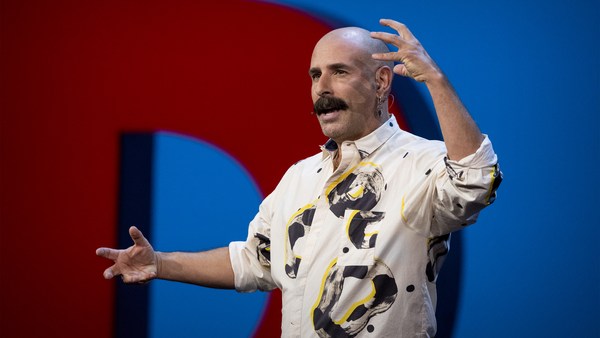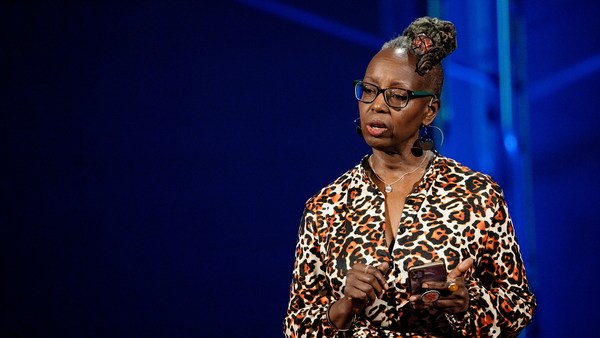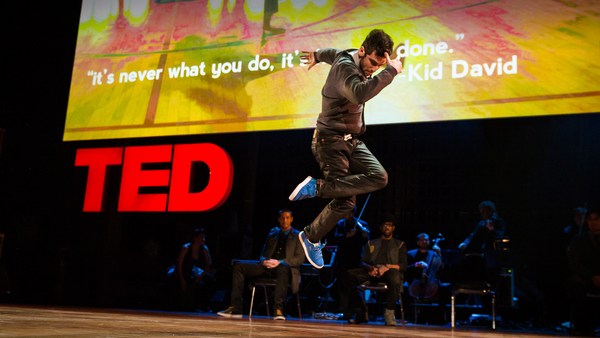(Percussion music)
(Applause)
Melaku Belay: (Speaking in Amharic)
Mehret Mandefro: The dance you just saw is my version of Eskista, a traditional dance from Ethiopia.
MB: (Speaking in Amharic)
MM: Eskista is deeply embedded in our way of life. Even though it's an ancient dance form, it can still tell contemporary stories of today.
MB: (Speaking in Amharic)
MM: The soundscape of my short dance transported me to Mercato, an open-air market in Addis Ababa, where you can find everything from horse saddles to spices to used cell phones.
MB: (Speaking in Amharic)
MM: The sound is of workers pounding recycled metal into useful objects.
MB: (Speaking in Amharic)
MM: Today, many shun the workers in Mercato. But I don't. I love to dance with them.
MB: (Speaking in Amharic)
MM: In the 1930s, Mercato was a place where Ethiopians traded with each other away from the prying eyes of Italian occupiers.
MB: (Speaking in Amharic)
MM: It was and still is, a place of Indigenous trading, not only of goods but of knowledge and creativity.
MB: (Speaking in Amharic)
MM: But our government wants to destroy Mercato and many other heritage places in the name of modern infrastructure.
MB: (Speaking in Amharic)
MM: Traditional community spaces hold Indigenous knowledge and memories that are crucial for ushering in cultural dignity, facilitating local economy and safeguarding society's well-being. When we lose community spaces, we lose hope, connection with each other, and opportunities to exchange energy and build peace together.
MB: (Speaking in Amharic)
MM: Dance is my protest, and Eskista is its contemporary expression for me.
MB: (Speaking in Amharic)
MM: I love my traditional dance because it is alive in the moment, and it leads us to the future.
MB: (Speaking in Amharic)
MM: I honor the many generations that came before us who have given us our dances that are always in the process of becoming anew. I dance to tell stories, like the endangerment of Mercato and other Indigenous spaces, in the name of development in Ethiopia.
MB: (Speaking in Amharic)
MM: Eskista itself originated in a moment of improvisation. It got its name from a folklore where a young woman hypnotized a snake by mimicking its own movements and sounds. It is beauty born out of the desire to survive.
MB: (Speaking in Amharic)
MM: Eskista saved my life too. In 1998, I was homeless, living on the streets of Addis Ababa. My street life changed when I found work as a dancer at Fendika Azmari, a traditional nightclub in Addis Ababa. I danced every single night for 12 years with no salary. For the first seven years after the customers left, I turned off the light and slept under the bar.
MB: (Speaking in Amharic)
MM: That's where I dreamt of telling the world about my Ethiopia of today through traditional dance. And my dreams came true. Along with Fendika’s traditional musicians, dancers and bands, I have performed all around the world.
MB: (Speaking in Amharic)
MM: With our rich music and dance, we tell contemporary stories that challenge the single narrative of Ethiopia, of hunger and war, stories that express our spirit of freedom and pride that Ethiopia was never colonized.
MB: (Speaking in Amharic)
MM: Now I'll dance, improvising to jazz music.
MB: (Speaking in Amharic)
MM: Why jazz, you might ask. Jazz, because it's an African music diasporic tradition and its feeling of freedom resonates in Ethiopia like Eskista does. In a way, dancing to jazz feels like going home. A deep connection with my people and the Ethiopian spirit of freedom. Jazz is about returning to yourself.
MB: (Speaking in Amharic)
MM: I invite you to join me and witness how ancient Eskista lives in the present moment.
MB: (Speaking in Amharic)
MM: Thank you.
(Applause and cheers)
(Jazz music)
(Music ends)
(Applause and cheers)





